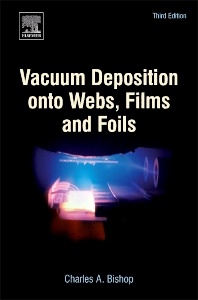Vacuum Deposition onto Webs, Films and Foils (3rd Ed.)
Auteur : Bishop Charles

Vacuum Deposition onto Webs: Films and Foils, Third Edition, provides the latest information on vacuum deposition, the technology that applies an even coating to a flexible material that can be held on a roll, thereby offering a much faster and cheaper method of bulk coating than deposition onto single pieces or non-flexible surfaces such as glass.
This technology has been used in industrial-scale applications for some time, including a wide range of metalized packaging. Its potential as a high-speed, scalable process has seen an increasing range of new products emerging that employ this cost-effective technology, including solar energy products that are moving from rigid panels onto cheaper and more versatile flexible substrates, flexible electronic circuit ?boards?, and flexible displays.
In this third edition, all chapters are thoroughly revised with a significant amount of new information added, including newly developed barrier measurement techniques, improved in-vacuum monitoring technologies, and the latest developments in Atomic Layer Deposition (ALD).
1. What is a Vacuum?2. Products using Vacuum Deposited Coatings onto Films or Foils3. Pressure Measurement4. Pumping 5. Process Diagnostics and Coating Characteristics6. Leaks, Water Vapour and Leak Testing7. Mass Spectrometers, Helium Leak Detectors and Residual Gas Analysers8. Substrates, Surface Quality, Cleaning, Adhesion and Adhesion Testing9. Adhesion and Adhesion Tests10. Surface Treatment of Webs and Foils11. Polymer Coatings12. Nucleation, Coalescence and Film Growth13. Pattern Metallization14. The D.C. Glow Discharge or Plasma15. Electron Beam (E-beam) Evaporation16. Thermal Evaporation17. Radiant Heated and Induction Heated Sources18. Chemical Vapour Deposition onto Webs and Foils19. ALD20. Planar Magnetron Sputtering Source Design and Operation21. Planar Magnetron Design Options22. Reactive Deposition, Set-up and Control23. Machine Specification and Build Issues and Risk Analysis Process24. Heat Load onto Webs and Foils25. Process Variables26. Mechanical Design27. Winding Webs in Vacuum28. Machine Building Trends29. System Design30. Hazards31. Troubleshooting32. Final Thoughts
Engineers and managers in the main industry sectors utilizing vacuum coating: food packaging, electronics, film production, pigment manufacturing, solar energy.
Research and Development staff
- Provides the know-how to maximize productivity of vacuum coating systems
- Thoroughly revised with a significant amount of new information added, including newly developed barrier measurement techniques, improved in-vacuum monitoring technologies, and the latest on Atomic Layer Deposition (ALD)
- Presents the latest information on vacuum deposition, the technology that applies an even coating to a flexible material that can be held on a roll, thereby offering a much faster and cheaper method of bulk coating
- Enables engineers to specify systems more effectively and enhances dialogue between non-specialists and suppliers/engineers
- Empowers those in rapidly expanding fields such as solar energy, display panels, and flexible electronics to unlock the potential of vacuum coating to transform their processes and products
Date de parution : 08-2015
Ouvrage de 602 p.
15x22.8 cm
Thème de Vacuum Deposition onto Webs, Films and Foils :
Mots-clés :
ALD; Abnormal glow discharge; Absorptance; Additives; Adhesion; Adhesion failure; Adhesion tests; Agglomeration; Air-to-air systems; Aluminum oxidation; Aluminum wire; Amorphous coating; Angular deposition; Anode; Anode dark space; Anode glow; Anodes; Arc; Arcing; Asphyxiation; Aston dark space; Atmospheric plasma; Atomic absorption spectroscopy; Atomic layer deposition; Atomic mass units; Balanced magnetron; Balanced magnetron source; Ballooning; Barrier; Barrier coatings; Batch systems; Bend test; Blowers; Boat corrosion; Boat erosion; Boat lifetime; Bond strength; Bourdon gauge; Buckling; CVD; Cantilever; Capacitance manometer; Capacitors; Carbonize; Cascade process; Chemical bombardment; Chemical hazards; Chemical reaction heat load; Chemical vapor deposition; Chemisorption; Chemometrics; Cleaning; Cleaning hazards; Coalescence; Coating growth; Coating uniformity; Coatings; Coefficient of friction; Cohesion failure; Cold cathode ionization gauge; Collection efficiency; Columnar growth; Conductance gaps; Conductivity; Conformal coating; Contamination; Control of arcs; Cooling substrates; Cooling uniformity; Cores; Corona; Cracking; Crookes dark space; Crucibles; Cryopanel; Cryopump; Crystal structure; Curing; Dead-fold test; Debris; Debris removal; Decomposition; Defects; Densification; Deposition drum; Deposition drum surface roughness; Deposition profile; Deposition shields; Deposition symmetry; Deposition uniformity; Design of experiments; Diagnostic tools; Diagnostics; Diffusion pumps; Diluents; Direct cooling; Disappearing anodes; Dissociation; Double side coating; Dual magnetron sputtering source



